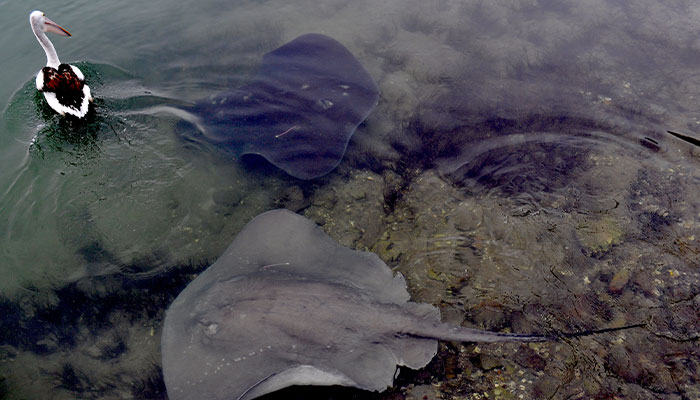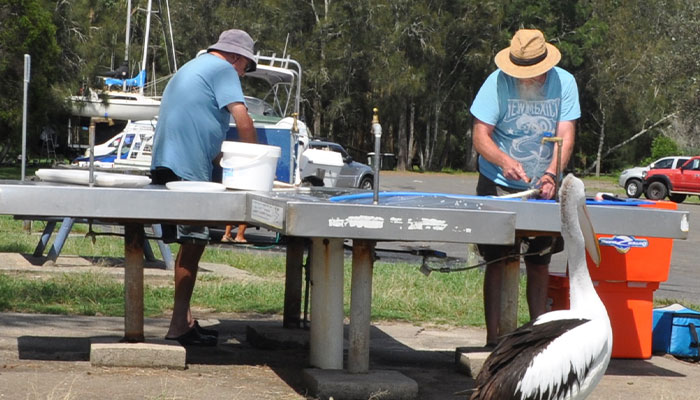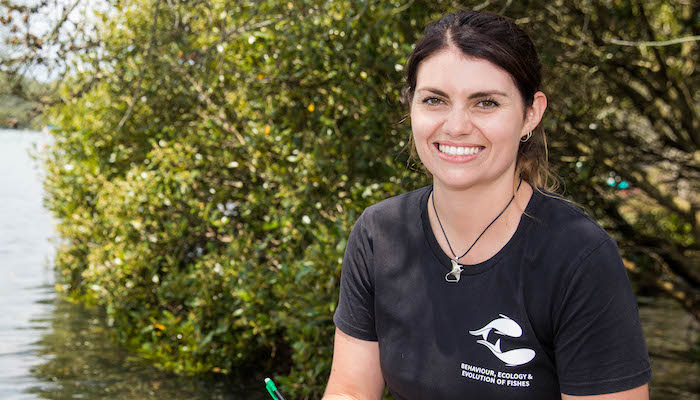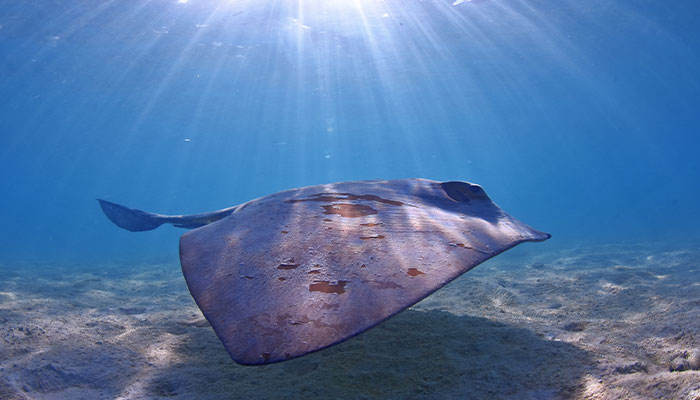A group of smooth stingrays living under the tyranny of a ‘large and in-charge’ female ruler, nicknamed Raylene, have given Macquarie University researchers a unique opportunity to document the social lives of stingrays.

Watch out: Members of the Jervis Bay 'fever' of stingrays who have been under observation by Macquarie University marine scientists. Photo credit: Joni Pini-Fitzsimmons. Tile photo credit: Barry Peters via Flickr
Raylene’s group – known collectively as a ‘fever’ – has been regularly visiting shallow waters in Jervis Bay, on the NSW South Coast, since a fish cleaning table was built next to the Woollamia boat ramp in the lower Currambene Creek in the 1980s.
Macquarie University marine scientists have observed the group since 2015, using tags and video-recordings to record how the stingrays interact with each other – and found signs of a structured despotic society most often observed in highly social animals like primates.
This research – the first evidence of a despotic social structure in a population of sharks or rays – has just been published in a special issue of Frontiers in Marine Science dedicated to social behaviour in marine animals.
Large and in-charge
“Raylene is quite a character with a massive personality and a ‘large and in-charge’ attitude, so she was one of the first stingrays we noticed at this site when we began researching here in 2015,” says Joni Pini-Fitzsimmons, the lead author on the paper.

Meet Raylene: Researchers found Raylene was the big boss, with all the other rays ranked on the same level, far below.
Raylene – the largest stingray in the group – chases others away from the food, even biting other stingrays and pinning them to the ground.
“She seems to tolerate some of the smaller rays, and one we’ve named Stumpy because she has lost her tail, sneaks in when Raylene is distracted chasing the larger ones away from the food,” says Pini-Fitzsimmons.
The scientists turned to social network analysis (SNA) to better understand the social lives of the stingrays by counting the social interactions between individuals – “a bit like analysing people’s Facebook pages,” says Professor Culum Brown, head of the Fish Lab and senior author of the paper.
She seems to tolerate some of the smaller rays, and one we’ve named Stumpy because she has lost her tail, sneaks in when Raylene is distracted.
SNA revealed that the society was highly structured and centred around the dominant female, Raylene.
The scientists also used a dominance hierarchy approach to look at the top-down structure.
“We found that Raylene was the big boss at the top, with all the other rays ranked on the same level, far below her,” says Pini-Fitzsimmons.
- Volunteers' vital role in 'pooping the scoop' for science
- Hero volunteers of the AIDS crisis tell their stories at last
“This is typical of a despotic social structure, where a single alpha individual rules.”
Brown says that combining these two kinds of social analysis techniques, in what is called heterarchy, allowed the researchers to hone in on the characteristics of this stingray society.
“We were surprised at how sophisticated their social behaviour was in this context. But this double-pronged approach is quite novel, so it may be that other sharks and rays are equally social,” he says.
Shallow ray
Smooth stingrays are the biggest of Australia’s stingray species, and there was previously little known about the behaviour of these benthic, or bottom-dwelling, marine scavengers.

Happy accident: The fish cleaning table built in the 1980s that has brought stingrays into the shallows, giving scientists a close-up view of their interactions.
“Normally shark and ray behaviour is very difficult to observe, but the rays at this site have been fed scraps from the fish cleaning table for more than 35 years,” says Pini-Fitzsimmons.
“This site gives us a really shallow environment to easily view the interactions between stingrays over quite a long period of time and analyse their social behaviour.”
The team tagged 15 stingrays in total, observing interactions between 13 of them, all female.
We were surprised at how sophisticated their social behaviour was in this context.
Pini-Fitzsimmons says that the smooth stingrays visiting the Jervis Bay boat ramp are almost always female, and the research team only found and tagged their first male smooth stingray in 2018, after ‘intense chumming’ to attract animals to be tagged.
Female smooth stingrays are much larger than their male counterparts, and probably hungrier as they put a lot of energy into reproduction, Pini-Fitzsimmons says.
Five of the 15 rays studied were gravid (expecting stingray pups) during the research period.
“An easy food source like the scraps from fish cleaning tables can help the females supplement their diet while also reducing the amount of energy required to chase after prey,” she says.
Long-term visitors
Pini-Fitzsimmons says that local fishers claim certain individual stingrays in this group have been around for decades. “There’s a strong, learned association between the stingrays and this site because of the fish scraps that are thrown in from the table,” says Pini-Fitzsimmons.

Despotic structure: Marine biologist Joni Pini-Fitzsimmons found a strong social hierarchy in stingrays on the NSW South Coast.
Although there is little data about the longevity of stingrays in the wild, based on the few stingrays in long-term captivity, the larger animals are believed to live for more than 40 years.
Pini-Fitzsimmons says that there’s very little research into stingray behaviour, but they are closely related to sharks and share many characteristics and behaviours.
Like sharks, smooth stingrays are thought to be solitary, only coming together for breeding or when trying to access a common food source.
- Teens reap benefits of good connections with teachers
- Sydney industrial zone goes green in Australia-first tree study
Some ray species that live in the open ocean – like cownose – tend to travel in large groups, she says, but this isn’t very common in benthic stingray species.
“Mangrove whiprays are gregarious as juveniles, probably for safety, and pink whiprays form large resting aggregations,” she says. “But other than that, it’s pretty rare in larger stingrays.”
The team have now tagged a number of stingrays with acoustic trackers and are doing more investigation into the private lives of rays, looking for different social structures within various groups.
“There's so much that we don't know about their social lives,” Pini-Fitzsimmons says.
Joni Pini-Fitzimmons is an academic in the Department of Biological Sciences and PhD Candidate in the Department's Fish Lab.
Dr Culum Brown is a Professor in the Department of Biological Sciences.



